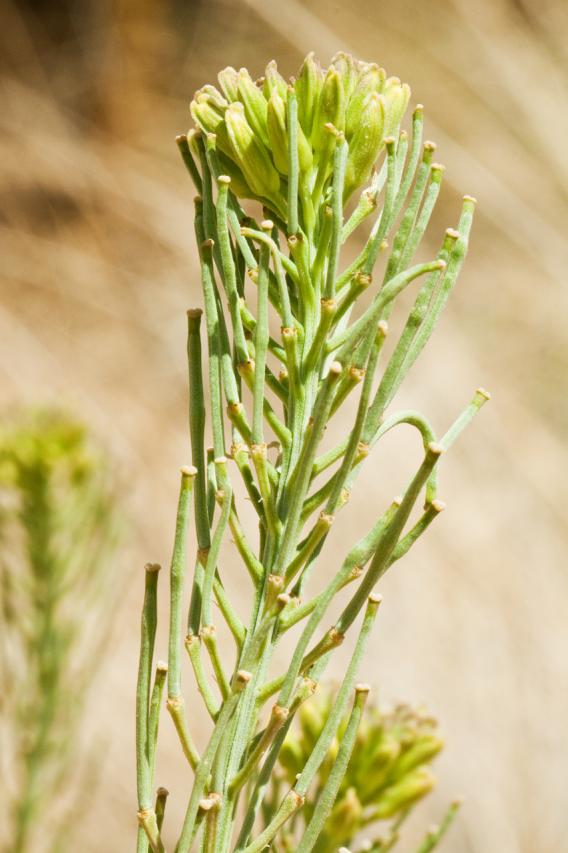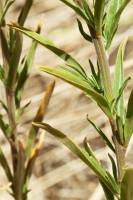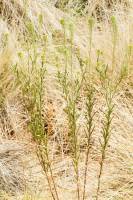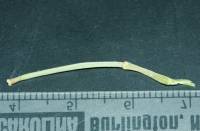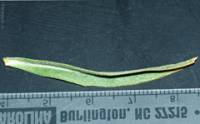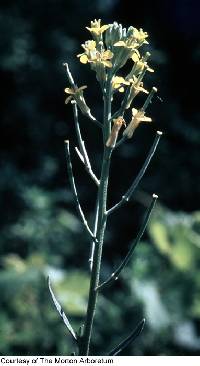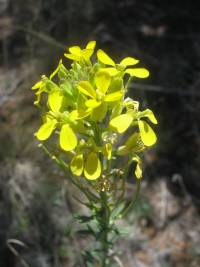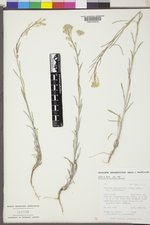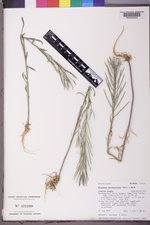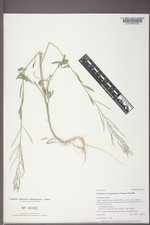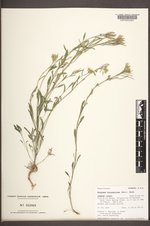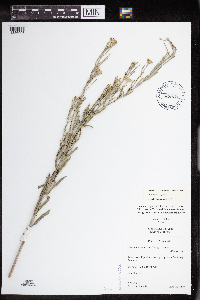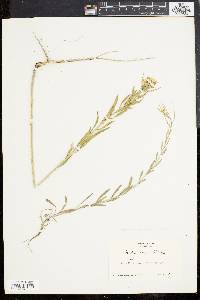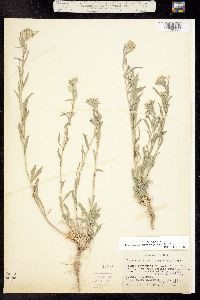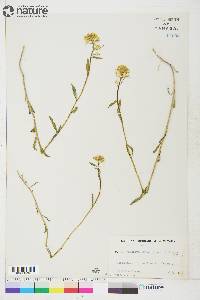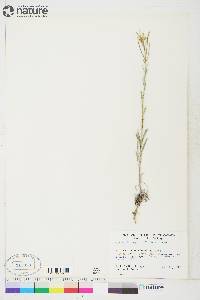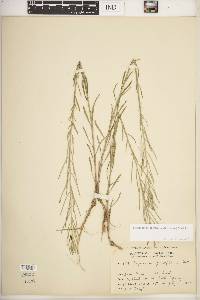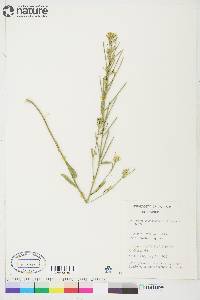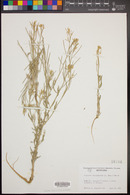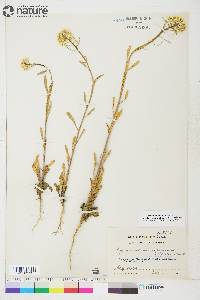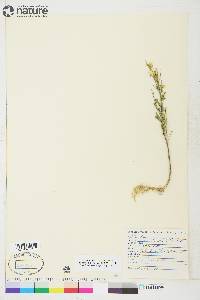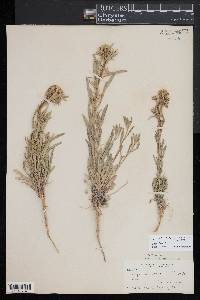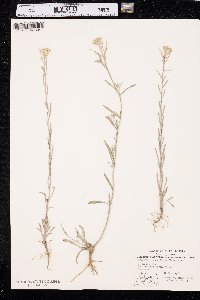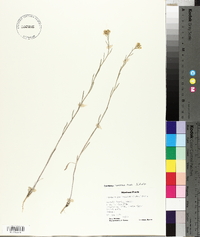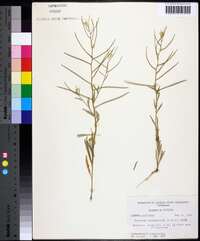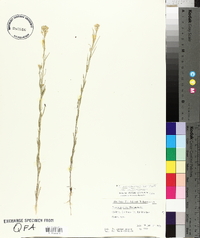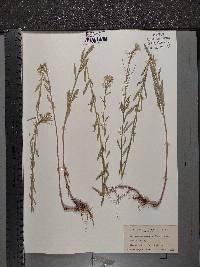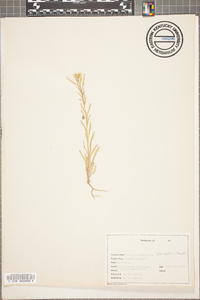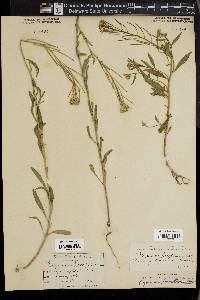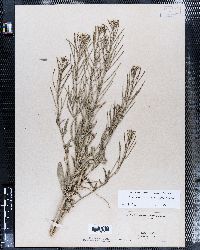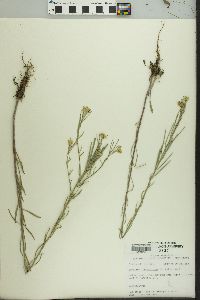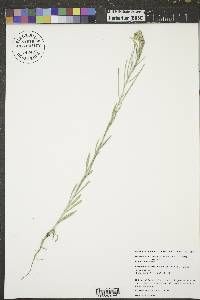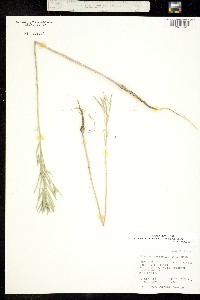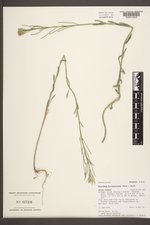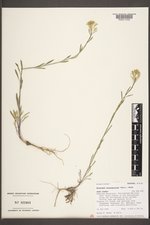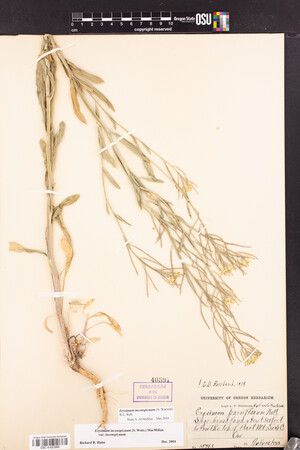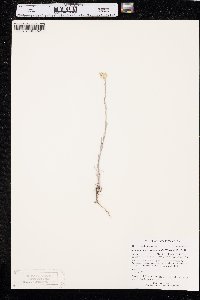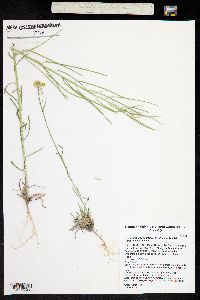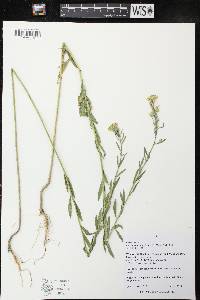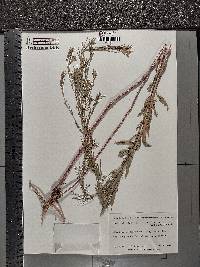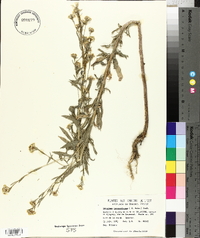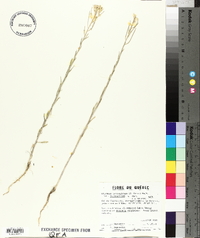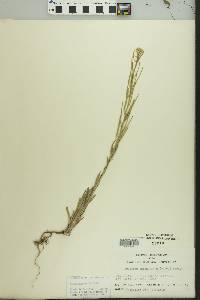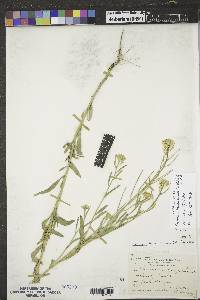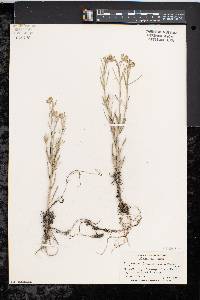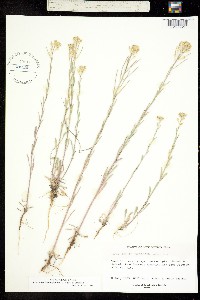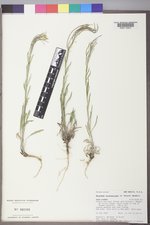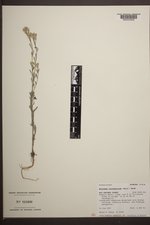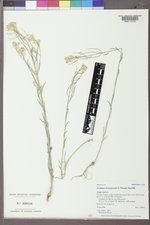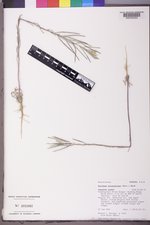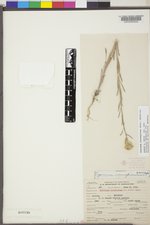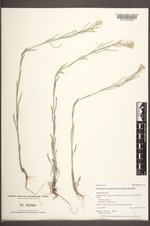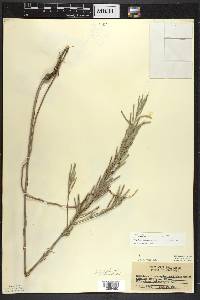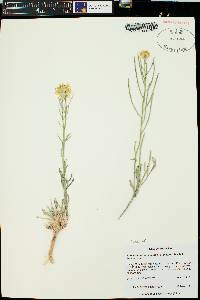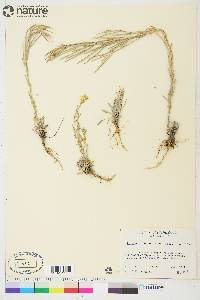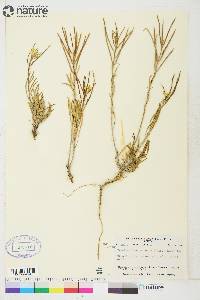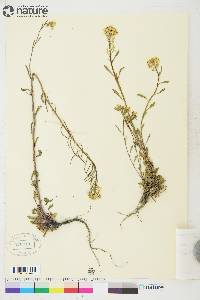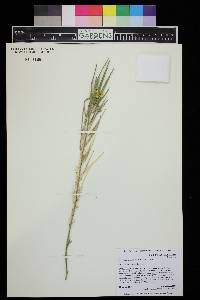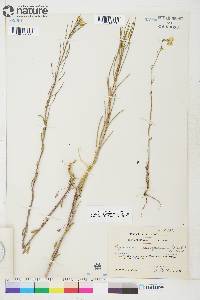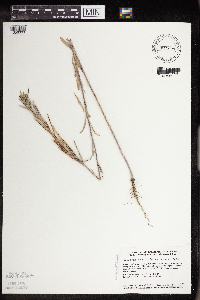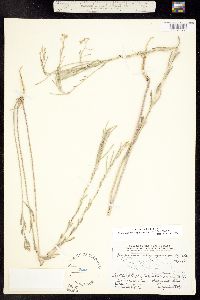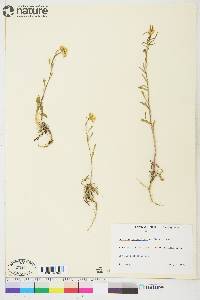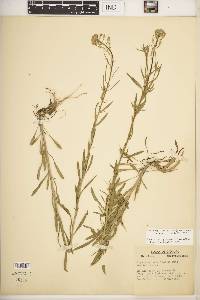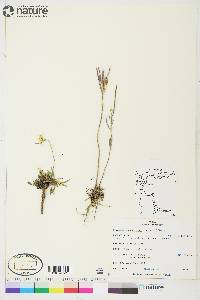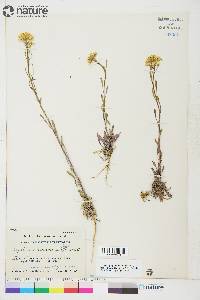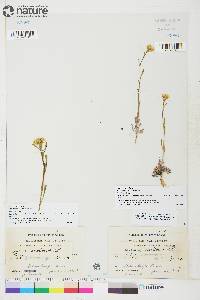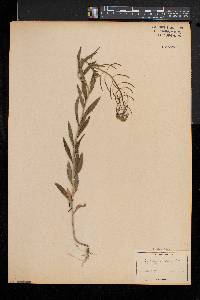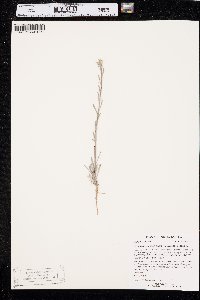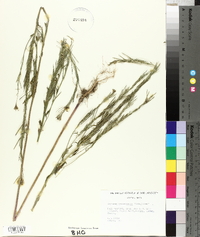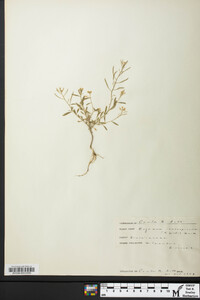
|
|
|
|
Family: Brassicaceae
Shy Wallflower, more...smallflower wallflower
[Cheirinia inconspicua (S. Wats.) Britt., moreErysimum inconspicum (S. Watson) MacMill., Erysimum parviflorum Nutt., Erysimum syrticolum] |
Biennials or perennials; (short-lived, caudex thickened, usually simple, rarely branched). Trichomes of leaves 2- or 3-rayed. Stems erect, unbranched or branched distally, 1.5-7 dm. Basal leaves: blade linear to linear-oblanceolate, 1.5-6(-8) cm × 2-8 mm, base attenuate, margins entire or dentate, apex acute. Cauline leaves (distal) sessile; blade margins entire or denticulate. Racemes elongated or not in fruit. Fruiting pedicels divaricate-ascending to ascending, stout, slightly narrower than fruit, 4-9(-15) mm. Flowers: sepals oblong to linear-oblong, 4-6 mm, lateral pair slightly saccate basally; petals yellow, oblanceolate, 6-9 (-11) × 1-2 mm, claw 5-7 mm, apex rounded; median filaments 5-7 mm; anthers narrowly oblong to linear, 1-2 mm. Fruits ascending to divaricate-ascending, (not appressed to rachis), narrowly linear, straight, not torulose, 3-5.8(-7) cm × 1-1.5(-1.8) mm, slightly 4-angled or terete, not striped; valves with somewhat prominent midvein, pubescent outside, trichomes 2-4-rayed, glabrous inside; ovules 36-66 per ovary; style cylindrical, stout, 0.7-3 mm, moderately to sparsely pubescent; stigma strongly 2-lobed, lobes as long as wide. Seeds ovoid, 1.2-1.7 × 0.8-1 mm; not winged or wing apiculate. 2n = 81. Flowering Apr-Aug. Calcareous talus and cliffs, roadsides, railroad embankments, abandoned fields, hillsides, alkaline ground, bluffs, crevices and ledges, gravel, prairies, rocky pastures, among brush, waste sites; 100-2700 m; Alta., B.C., Man., N.S., Ont., Que., Sask., Yukon; Alaska, Ark., Colo., Idaho, Ill., Ind., Kans., Maine, Mich., Minn., Mo., Mont., Nev., N.H., N.Y., N.Dak., Ohio, Okla., Oreg., S.Dak., Utah, Wis., Wyo. Erysimum inconspicuum is known in Yukon from Raup & Correll 11255 (A), which was collected 7 miles east of Little Atlin Lake, and Malte s.n. (GH), which was collected from Dawson on 10 August 1916. Most of the other collections from Yukon identified as E. inconspicuum belong to E. coarctatum. The record from Quebec is based on Cayouette J80-8 (GH), from Cté de Charlevoix, and Victorin, Germain, & Meilleur 43128 (GH), from Du Lac-Saint-Jean.
Perennial herb 30 cm - 0.8 m tall Stem: upright, usually unbranched, grayish green, very hairy. Leaves: alternate, usually upright or ascending, grayish green, linear to oblong, mostly non-toothed. The upper leaf surface is covered with a mix of two-pronged and three-pronged hairs. The upper leaves are rarely over 5 mm wide. Flowers: in a long, branched cluster (raceme). Stalks ascending, 3 - 9 mm long, stout. Sepals four, 4.5 - 7 mm long, densely hairy. Petals four, pale yellow, 6 - 10 mm long. Stamens six. Fruit: a long, narrow pod, upright or nearly so, 1.5 - 4 cm long, four-angled, and hairy. Seeds in one row. Similar species: The similar Erysimum cheiranthoides differs by having petals that do not typically exceed 5 mm long, sepals that do not typically exceed 3.5 mm long, and fruit that does not typically exceed 3 cm long. Erysimum hieraciifolium differs by having leaves with four-pronged hairs on the upper surface and toothed margins. Erysimum repandum, which is a pale green annual, typically has fruit more than 5 cm long. Flowering: mid-June to mid-July Habitat and ecology: Introduced from farther west of the Chicago Region. Local along railroads and in other disturbed areas. Look for it in both sandy and gravelly soils, especially on dry sites. Occurence in the Chicago region: non-native Etymology: Erysimum comes from the Greek word eryomai, meaning "to help or save," which refers to the medicinal qualities of some species. Inconspicuum means inconspicuous. Author: The Morton Arboretum FNA 2010, Heil et al. 2013, Allred and Ivey 2012 Duration: Perennial Nativity: Native Lifeform: Forb/Herb General: Biennial to short-lived perennial herbs, 15-70 cm tall, from thickened caudex; stems erect, usually unbranched (sometimes branched above the middle). Leaves: Basal leaves often persistent through flowering and fruiting; stem leaves alternate; blades linear to linear-oblanceolate, 1.5-8 cm long and 2-8 mm wide, with attenuate bases, pointed tips, and entire or dentate margins; covered with 2-3 rayed stellate hairs. Flowers: Yellow, in dense terminal racemes which usually elongate in fruit; pedicels ascending in flower, spreading to ascending when in fruit, 4-15 mm long, and somewhat stout, only slightly narrower than the seed pods; sepals oblong , 4-6 mm long, the lateral pair slightly sac-shaped at the base; petals oblanceolate, 6-11 mm long and 1-2 mm wide, yellow. Fruits: Capsules narrowly linear, straight, 3-7 cm long and 1-2 mm wide, slightly 4-angled or terete but not striped, ascending to spreading-ascending; seeds ovoid, 1-2 mm long. Ecology: Found on calcareous talus and cliffs, roadsides, railroad embankments, abandoned fields, hillsides, alkaline ground, bluffs, crevices and ledges, gravel, prairies, rocky pastures, among brush, and at waste sites, below 9,000 ft (2743 m); flowers April-Aug Distribution: Rocky Mountain states, Pacific Northwest east of the Cascades, Midwest, New England, and Canada. Notes: Erysimum spp. (the wallflowers) are tall, erect, generally unbranched biennials or perennials, with persistent clusters of narrow basal leaves and similar stem leaves; and stems ending in dense clusters of yellow to orange flowers which become long narrow seed pods when mature. E. inconspicuum is distinguished by having small yellow flowers, with petals less than 12 mm long; pedicels narrower than the seed pods; and seed pods at least 3 cm long. FNA (2010) does not include Arizona or New Mexico as part of the species' range; however, the Flora Neomexicana (2012) states that E. inconspicuum is present but uncommon in New Mexico, and the Four Corner Flora (2013) specifically lists it as present in northwest Arizona and northeast New Mexico. Ethnobotany: Hopi used it as a tuberculosis remedy. Etymology: Erysimum is from the Greek eryomai, to help or save, referring to the medicinal properties; inconspicuum refers to the small, inconspicuous flowers. Editor: AHazelton 2017 Erect, often simple perennial 3-8 dm; lvs mostly erect or ascending, linear to oblanceolate, entire or obscurely and remotely sinuate-dentate, the cauline rarely over 5 mm wide; pubescence of the upper lf-surface of mixed 2-pronged and some 3-pronged hairs; sep densely stellate, 5-7 mm; pet pale yellow, 6-10 mm; anthers (1.5-)2-2.5 mm; mature racemes elongate, the stout, ascending pedicels 3-9 mm; frs erect or nearly so, 1.5-4 cm; 2n=54. Dry soil of prairies, plains, and upland woods; Alas. to Nev., e. to Man., Minn., and n. Mich., and occasionally adventive eastward. May-Aug. (E. parviflorum; Cheirinia inconspicua; C. syrticola) Gleason, Henry A. & Cronquist, Arthur J. 1991. Manual of vascular plants of northeastern United States and adjacent Canada. lxxv + 910 pp. ©The New York Botanical Garden. All rights reserved. Used by permission. From Flora of Indiana (1940) by Charles C. Deam Indiana Coefficient of Conservatism: C = Wetland Indicator Status: |
|
|
|

